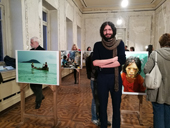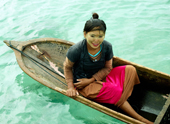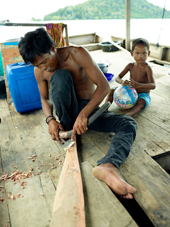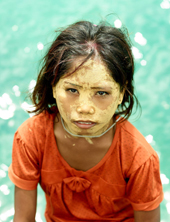
The Last Nomads
By Gvantsa Turmanidze
Monday, March 18
On March 15, 2019, Tbilisi State Silk Museum hosted a photo exhibition “The Last Nomads”, which is a project by an artist Vargha Bahagir, born in Iran in 1979 and based in Finland since 2000. Vargha is a documentary photographer, whose works are commonly focused on indigenous people and ethnic minorities.
The Director of the State Silk Museum Ms. Nino Kuprava explained that the exhibition was organized in the framework of the long term project of the Museum - „Transcontinental Network Far and Near" initiated by the head of the Museum’s Friends Association Ms. Trang Hoang. The idea of the project was to enable all foreign artists working in Georgia to present their artworks. Three events have already been implemented in the framework of this project and this is the fifth exhibition now. “This project is interconnected with big Silk Road project, which has started centuries ago and is now developing through new migrations and movements and contacts between the institutions or particular groups of people”, said Ms. Kuprava.
The photographic exhibition depicting two ethnic minorities Bajau Laut and Rautehas started in 2014. Through his photographs, Vargha Bahagir shares his fascination about these ethnic groups and shows us beautiful images of some of the last true nomads and their living habits.
"Being an immigrant myself, having also spent years on the road, I have always found myself affected and attracted to the subject of human moving and relocation. Constantly reflecting on the subject, I keep asking myself why humans migrate, and what social, cultural, religious, or economic motives underlie the phenomenon. For the modern world, awareness of how others live miles and oceans away from them is a cultural and educational necessity. This can better familiarize us with our ancient roots. In this way, photography is an excellent medium" –said Vargha Bahagir.
There’s an annotation displayed at the exhibition telling a short story of the nomads:
“Bajau Laut - known as "sea gypsies" and "the last of the sea nomads", the Bajau Laut have long been surfing the sea between Malaysia, the Philippines, and Indonesia.
They are fishermen, which is their only profession as well as their source of food. With no public buildings such as schools and hospitals around, Bajau women and children spend their days in boats and palapas, where kids enjoy swimming and playing games.
Girls are used to wearing masks composed of rice “bedak beras” that protect them from the sun. The average marriage age for women is 15-16.
Raute - calling themselves the “kings of the forest”, the Raute is Nepal’s only nomadic tribe. They live in primitive camps in remote parts of the forests in Western Nepal.
The Raute are hunter-gatherers. They are known for subsistence hunting of monkeys. They use tree trunks for the making of bowls and boxes, which will later be traded for rice, clothes, etc.
They move from one place to another on a regular basis, which takes between one week and two months or a day after a fellow member dies”.
The author of the photographs mentioned, that during the last few decades many of these nomads have been forced to settle permanently by the local government, but they don’t accept it as for the "sea gypsies" the sea is there home and for the “kings of the forest” it is impossible to stay at one place for a long time. The nomads also don’t like to be somehow involved in global changes or affected by new technologies.
The exhibition will last until March 30th, 2019.




